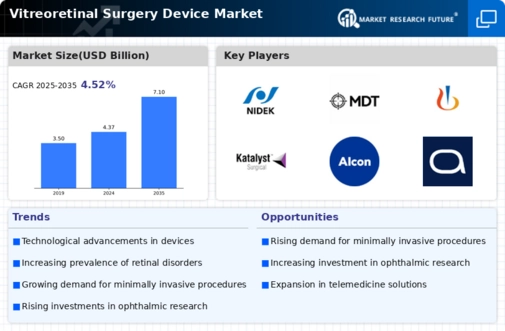Rising Healthcare Expenditure
An increase in global healthcare expenditure is fostering growth in the Global Vitreoretinal Surgery Device Market Industry. Countries are investing more in healthcare infrastructure, which includes the procurement of advanced surgical devices. According to the World Bank, global health expenditure is projected to reach approximately 10 trillion USD by 2024, indicating a robust commitment to enhancing healthcare services. This financial support enables hospitals and surgical centers to acquire state-of-the-art vitreoretinal devices, thereby improving surgical outcomes and patient care. As healthcare budgets expand, the market for vitreoretinal surgery devices is expected to flourish.
Increasing Prevalence of Eye Disorders
The rising incidence of eye disorders globally is a primary driver for the Global Vitreoretinal Surgery Device Market Industry. Conditions such as diabetic retinopathy, retinal detachment, and age-related macular degeneration are becoming more prevalent, necessitating advanced surgical interventions. For instance, the World Health Organization indicates that diabetic retinopathy affects approximately 1 in 3 individuals with diabetes, highlighting the urgent need for effective treatment options. As the global population ages and the prevalence of diabetes rises, the demand for vitreoretinal surgeries is expected to increase, contributing to the market's growth.
Growing Awareness and Screening Programs
There is a growing awareness of eye health and the importance of early detection of retinal diseases, which is driving the Global Vitreoretinal Surgery Device Market Industry. Public health campaigns and screening programs are increasingly being implemented worldwide, encouraging individuals to undergo regular eye examinations. For instance, initiatives by organizations such as the International Agency for the Prevention of Blindness aim to reduce the incidence of blindness through early detection and treatment. As more individuals become aware of the risks associated with untreated eye conditions, the demand for vitreoretinal surgeries is likely to rise, further propelling market growth.
Projected Market Growth and Financial Metrics
The Global Vitreoretinal Surgery Device Market Industry is poised for substantial growth, with projections indicating a market value of 4.37 USD billion in 2024 and an anticipated increase to 7.1 USD billion by 2035. This growth represents a compound annual growth rate (CAGR) of 4.51% from 2025 to 2035. Such financial metrics suggest a robust demand for vitreoretinal surgical devices driven by technological advancements, increasing prevalence of eye disorders, and rising healthcare expenditures. Stakeholders in the healthcare sector are likely to capitalize on this growth trajectory, investing in innovative solutions to meet the evolving needs of patients.
Technological Advancements in Surgical Devices
Technological innovations in vitreoretinal surgical devices are significantly enhancing the capabilities of surgeons and improving patient outcomes. The Global Vitreoretinal Surgery Device Market Industry is witnessing the introduction of advanced tools such as high-definition visualization systems, improved surgical lasers, and minimally invasive techniques. These advancements not only facilitate more precise surgeries but also reduce recovery times for patients. For example, the integration of 3D visualization technology allows surgeons to perform complex procedures with greater accuracy. As these technologies continue to evolve, they are likely to drive market growth, attracting more healthcare providers to adopt these advanced solutions.


















Leave a Comment